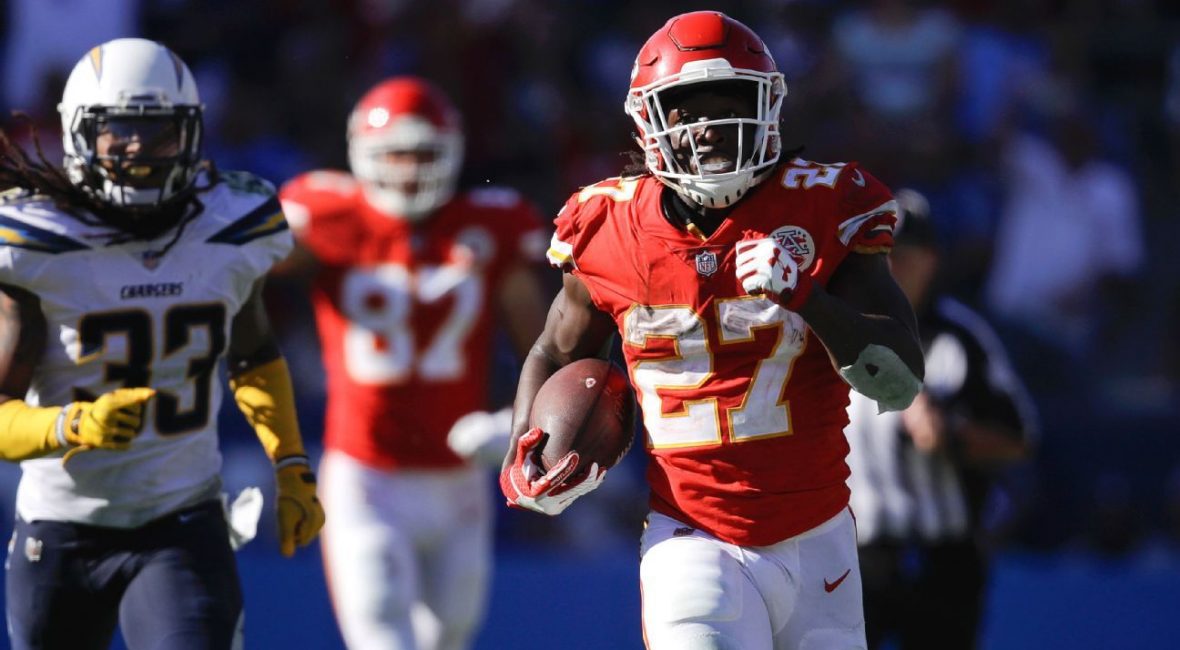Kareem Hunt's next challenge is to keep doing what he's doing

KANSAS CITY, Mo. — Larry Johnson once was where Kareem Hunt is now, a running back for the Kansas City Chiefs who developed into a premier player seemingly overnight. Johnson rushed for more than 100 yards in his first three games after becoming Kansas City’s featured back in 2004.
Johnson’s coming-out party wasn’t as spectacular as that of Hunt, a rookie who, heading into this weekend’s games, leads the NFL in rushing yards with 401 and is tied for the lead in touchdowns with six.
But it was more than strong enough to get the attention of the Chiefs’ opponents the remainder of that season and beyond. That makes Johnson an excellent person to offer Hunt some friendly advice about what’s ahead.
“If I was him, I’d enjoy this now,” Johnson said. “Nobody around the league knows what he can do. He’s seeing what I saw when I first got started.
“I knew, especially in that 400-carry season (2006), every team was going to put eight men [at the line of scrimmage] against me. He’s not seeing that yet. Trust me, after another few games he’s going to start seeing corner blitzes, safety blitzes, linebacker blitzes. They’re going to really test him now just to keep him in the pocket so he’s not a receiving threat. They’re going to test his toughness by bringing more guys to the [line]. That’s how it was for me. You have to mentally prepare yourself for teams to game-plan for you.
“Let me tell you, that’s not easy. The longer you do it, the tougher it gets.”
Hunt has been the biggest star for the Chiefs, who are 3-0 heading into Monday night’s game against Washington (8:30 ET, ESPN) at Arrowhead Stadium. He has at least 100 yards from scrimmage in every game. The only rookies in NFL history to begin their seasons with more than three such games are Adrian Peterson (five) in 2007, LaDainian Tomlinson (four) in 2001 and Billy Sims (four) in 1980.
That’s great company for Hunt, a third-round pick. Keeping that pace or merely staying close will get more difficult, as Johnson and Chiefs coach Andy Reid suggest, because the bull’s-eye Hunt soon will be wearing during games tends to get heavy.
“He’s young in this, not only in age and experience, but he’s young in the season here,” Reid said. “The challenges are going to be answering the bell every week, physically and mentally.”
Hunt did nicely with a big workload in college at Toledo. He got the ball more than 850 times in four seasons and was productive throughout, averaging 6.3 yards per carry.
“I played the whole college season and I felt like I got better as the season went on too,” Hunt said. “You’ve got to keep going through it and keep taking care of your body each and every day. Do the most that you can do. Live in the training room, do little things to take care of your body.
“It starts now, just taking care of your body every day and just doing little things. Even when you’re not that sore, you’ve just got to keep working to get your body all the way back together, so you’ve got to take it day by day and week by week.”
The NFL is different than college, with more games and bigger and faster players. There’s also a mental and physical aspect to succeeding over the long haul.
That’s something another former great Chiefs back, Priest Holmes, can speak to.
“Running back is a position I call the ‘Warrior Position’ because of the amount of hits you’re taking during a game,” Holmes said. “Just to wake up on Monday morning and feel the way you do and then to know what the week ahead is going to bring, that can be difficult for a lot of players. You have to have something special to handle that, to anticipate being successful.
“I’m sure [Hunt] can do that. He looks like a special player.”
Curtis Martin didn’t play for the Chiefs, but is one of the best examples of a running back who was one of the NFL’s top players for an extended period. He missed just eight games over an 11-year career (1995-2005) spent with the New York Jets and New England Patriots, and between carries and receptions got the ball more than 300 times each season except one, his final campaign.
One of the assistant coaches during much of Martin’s time in New York was Bob Sutton, now the Chiefs’ defensive coordinator. All these years later, Sutton marvels at how Martin could withstand the punishment and come back week after week for more.
“Curtis was one of the most unique people I’ve ever been around,” Sutton said. “He had unbelievable focus. I don’t know if I’ve seen anybody have the focus he has and the great ability to control his own mind. I saw him get ready to play against Buffalo with two high-ankle sprains. He played and he played well. That’s supposed to be an injury that keeps you out however many weeks.
“He had great skills, great talent. He was a great runner. He was powerful for not a really big man. But he was just an unbelievable individual when he was getting ready for a game. To me, that defined Curtis. That made him different than a lot of backs in our league. Nothing else mattered to him than getting ready to play. Not many people can do that on a consistent basis.”
Reid said Hunt will be helped by working daily with running backs coach Eric Bieniemy, a former NFL player.
“He’s got [Bieniemy] in his hip pocket, right?” Reid said. “He does a phenomenal job with him. He’s been there as a player. He understands the challenges of that position. To have somebody like Eric is an important part of this.”
Bieniemy might help, but to hear Holmes and Johnson talk, much of the ability to handle the burden of being an NFL running back has to come from within. Either Hunt has the ability or he doesn’t.
“What drove me to answer that bell every week was crossing that goal line,” said Holmes, who led the NFL in touchdowns in 2002 (24) and 2003 (27). “I could make 70,000 people love me or I could make 70,000 people hate me just by scoring a touchdown, depending on whether we were home or away.
“That’s unique and different for every player. It’s not the same thing that’s going to get everybody ready for the call. But you have to have a prize, a goal, something to have your sights on. For me, it was always crossing that goal line, whether it took one play to do it or 10 plays or 20 plays.”
Johnson had a different ritual.
“I would watch a lot of tape of my runs, but I didn’t watch tape of the 2- and 3-yard runs,” he said. “I would watch the runs that were 10 yards and over. That built my confidence. I would watch tape of my runs against teams with tough defensive fronts. That built my confidence knowing and seeing those defenses could be hurt, that it was just a matter of time, that I could be successful against those defenses.”
Things worked out well for Holmes, who was able to sustain great success from the time he joined the Chiefs in 2001 until an injury in 2004 pushed his career into a decline.
Johnson didn’t manage as well for a long period, but was spectacular in 2005 and 2006 with more than 1,700 yards in each season.
Hunt looks poised to join Holmes and Johnson as great backs in Chiefs history. He’s got 13 more regular-season games this season to show he can handle the pressure and defensive attention that is sure to come his way.
“He’s a pretty humble kid,” Reid said. “With his makeup, he’ll be fine doing it.”





